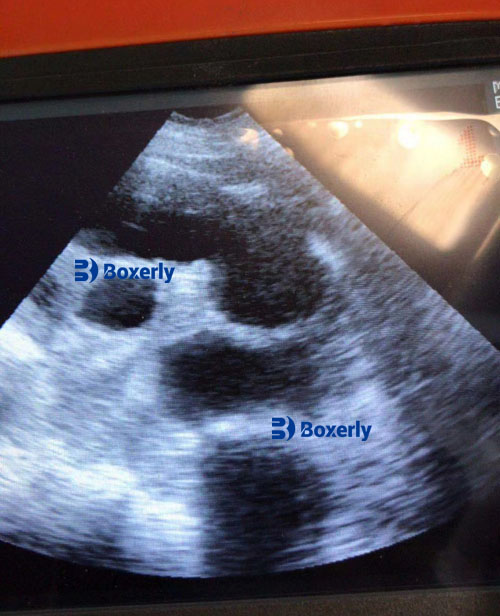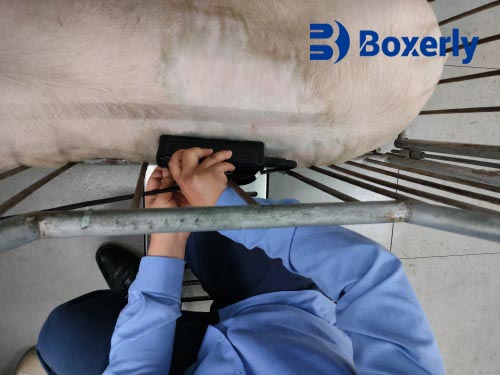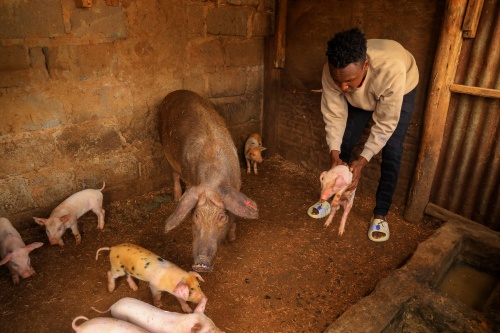Veterinary Ultrasound in Boar Management
As swine producers strive to improve breeding success, the role of veterinary ultrasound has expanded far beyond pregnancy diagnosis. In recent years, it has become a vital management tool in the care and feeding of breeding boars (mature male pigs). Ensuring optimal health, reproductive ability, and semen quality in boars is critical to the profitability of commercial pig operations. In this article, I will explore how veterinary ultrasound contributes to modern boar management, particularly by helping producers monitor body condition, reproductive organ health, and semen quality—factors closely tied to nutrition, exercise, and overall welfare.

The Boar’s Role in Swine Reproduction
In any breeding program, the boar plays a key role. A single healthy boar can sire hundreds of piglets in a year, especially in artificial insemination (AI) systems. To perform at this level, the boar must remain active, lean but muscular, and sexually vigorous. Unfortunately, poor nutrition, inadequate management, and environmental stressors can all compromise boar fertility.
Key factors affecting boar performance include:
-
Balanced nutrition (especially protein, vitamins, and minerals)
-
Appropriate body condition (not too fat or too thin)
-
Regular exercise
-
Clean, comfortable housing
-
Monitoring of reproductive health
Veterinary ultrasound—especially B-mode ultrasonography—provides insight into these areas, giving producers data to make better decisions about feeding, housing, breeding, and health interventions.

Understanding Body Condition with Ultrasound
Maintaining ideal body condition is essential for a boar’s breeding capacity. If a boar becomes overweight, he may become lethargic, show reduced libido, and have difficulty mounting or mating. Conversely, if he is too thin—due to overuse in breeding or poor nutrition—he may produce poor-quality semen or lose interest in mating altogether.
Using ultrasound, farmers can assess backfat thickness and muscle development to determine whether the boar’s condition is within the ideal range. Studies in Europe and the United States suggest that backfat thickness should ideally range between 16 and 24 mm, depending on breed and age. Excessive backfat indicates overfeeding or lack of exercise, while thin fat layers may indicate underfeeding or overuse.
Unlike traditional visual scoring systems, ultrasound provides precise, quantitative measurements, making it easier to tailor feeding programs to individual animals. For example, if a boar is gaining too much fat, his ration can be adjusted to reduce energy-dense feed and increase physical activity. If he is losing muscle, the diet can be adjusted to include more protein-rich ingredients like soybean meal or fishmeal.
Nutritional Management: A Science-Backed Approach
Boars require high levels of protein, vitamins, and minerals to sustain daily sperm production. Semen is rich in proteins, phosphorus, zinc, and other micronutrients. Therefore, repeated breeding increases nutritional demands. In many parts of the world, including China and Southeast Asia, producers supplement boar diets with high-protein foods like duck eggs during peak mating seasons—a practice supported by science.
International best practices recommend:
-
A slightly higher concentrate-to-roughage ratio in boar diets compared to sows
-
Balanced amino acid profiles, especially lysine
-
Supplements like selenium, vitamin E, and zinc to improve sperm motility and viability
-
Avoiding excessive carbohydrates that lead to obesity
Ultrasound helps producers see the results of their nutritional strategies. If body fat increases too fast, adjustments can be made before fertility suffers. If a lean boar is struggling to maintain muscle mass, that’s also a sign to re-evaluate his protein intake.

Monitoring Reproductive Health with Ultrasound
Another major benefit of veterinary ultrasound is its ability to assess the boar’s reproductive organs. By scanning the testicles, producers and veterinarians can observe testicular size, symmetry, echotexture (internal appearance), and blood flow. These parameters are closely related to sperm production capacity and semen quality.
Abnormalities such as testicular degeneration, swelling, or mineralization can be detected early. In Europe and North America, routine ultrasound scans are increasingly used in breeding stations to screen boars before collecting semen for artificial insemination. This avoids costly errors caused by using subfertile or infertile males.
Veterinarians can also use Doppler ultrasound to evaluate blood flow to the testes. Reduced circulation may suggest inflammation, heat stress, or other health issues—all of which can affect fertility. Early diagnosis through imaging allows for prompt intervention, whether by adjusting housing temperatures, changing diet, or administering medication.
Improving Housing and Exercise Through Monitoring
Housing design and exercise routines also affect boar health. Boars kept in confined, poorly ventilated pens often suffer from joint problems, obesity, and heat stress. Daily exercise helps maintain muscle tone, improves appetite, and enhances reproductive drive.
Many modern producers schedule twice-daily exercise for boars, allowing them to walk for 30 minutes each time. This practice, common in Scandinavian and Canadian systems, not only improves physical condition but also increases semen output.
Ultrasound provides feedback on how exercise is affecting the animal. If a previously overweight boar shows reduced fat thickness and improved muscle definition on follow-up scans, the program is working. If not, housing or feeding routines may need to be revised.
Seasonal Management: Cooling in Hot Weather
Boars are particularly vulnerable to heat stress, which can drastically reduce sperm quality. In hot climates or summer months, producers use cooling systems, showers, and even pig-sized swimming pools to help boars stay cool.
In Sweden and Germany, brushing the skin with stiff brushes or using showers twice a day during summer is a common practice. These practices stimulate blood circulation, prevent skin infections, and reduce parasites like mites or lice. All of these factors contribute to higher semen quality.
With ultrasound, the impact of heat stress can be observed in the testicles: reduced echogenicity or shrinking of testicular volume often indicates damage. This allows the producer to take immediate action—such as adjusting ventilation or scheduling breeding earlier in the day.

Group Management Strategies
When managing multiple boars, group exercise and feeding become logistical challenges. Grouping boars by size and temperament can reduce fighting and injuries during group exercise. In Northern European systems, boars raised together from a young age tend to be less aggressive when exercised in groups.
When group exercise is introduced in adult boars, it’s essential to remove tusks to prevent serious injury. Careful observation is needed during the early phases of group activity to ensure harmony.
Veterinary ultrasound helps monitor the effects of group management on individual boars. Differences in body condition and reproductive health can be tracked to ensure no animals are being outcompeted or stressed.
Contributions to Semen Quality and Fertility
Ultimately, all aspects of boar management—nutrition, housing, exercise, and stress reduction—serve one primary goal: maximizing semen quality and fertility. Veterinary ultrasound plays a key role by allowing producers to observe the link between management changes and physiological results.
High-quality semen is characterized by:
-
High volume and sperm concentration
-
High sperm motility and viability
-
Low incidence of abnormal sperm
These qualities are directly influenced by testicular size and health, body condition, and general welfare—all of which can be monitored using ultrasound.
Conclusion
Veterinary ultrasound is no longer just a tool for diagnosing pregnancy in sows—it is a powerful, real-time, non-invasive technology that supports every aspect of boar management. From tracking body condition and muscle development to evaluating reproductive organs and monitoring the impacts of nutrition and heat stress, ultrasound gives swine producers the data they need to optimize productivity.
By integrating ultrasound scanning into routine boar management, producers can detect problems early, fine-tune feeding plans, and improve both animal welfare and reproductive efficiency. As awareness of these benefits continues to grow globally, veterinary ultrasound will become an essential part of modern boar management systems.





